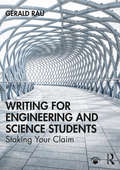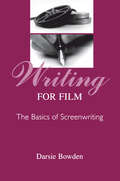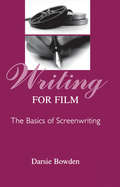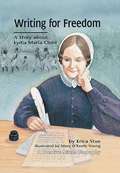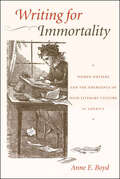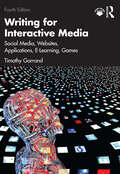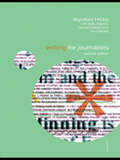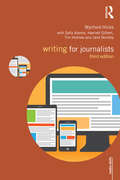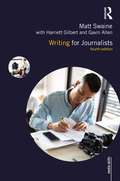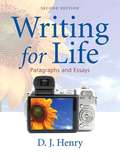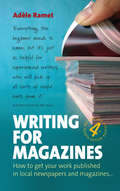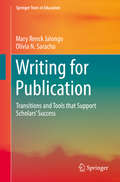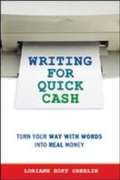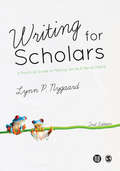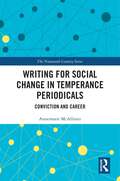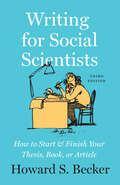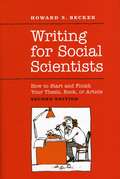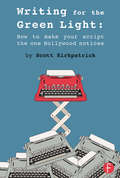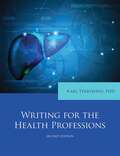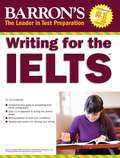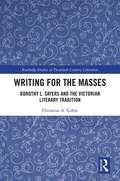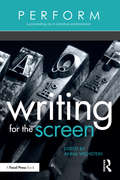- Table View
- List View
Writing for Engineering and Science Students: Staking Your Claim
by Gerald RauWriting for Engineering and Science Students is a clear and practical guide for anyone undertaking either academic or technical writing. Drawing on the author’s extensive experience of teaching students from different fields and cultures, and designed to be accessible to both international students and native speakers of English, this book: Employs analyses of hundreds of articles from engineering and science journals to explore all the distinctive characteristics of a research paper, including organization, length and naming of sections, and location and purpose of citations and graphics; Guides the student through university-level writing and beyond, covering lab reports, research proposals, dissertations, poster presentations, industry reports, emails, and job applications; Explains what to consider before and after undertaking academic or technical writing, including focusing on differences between genres in goal, audience, and criteria for acceptance and rewriting; Features tasks, hints, and tips for teachers and students at the end of each chapter, as well as accompanying eResources offering additional exercises and answer keys. With metaphors and anecdotes from the author’s personal experience, as well as quotes from famous writers to make the text engaging and accessible, this book is essential reading for all students of science and engineering who are taking a course in writing or seeking a resource to aid their writing assignments.
Writing for Film: The Basics of Screenwriting
by Darsie BowdenIn this introduction to screenwriting, author Darsie Bowden provides sage, real-world advice and instruction on the process of writing film screenplays. This text will help budding screenwriters to structure their dramas, refine their characterizations, and craft their language, while also introducing them to the appropriate screenplay formats. It covers the complexities of writing for the screen and points out the contradictions to expect if readers pursue this work as a career. In addition to covering the elements of the dramatic film screenplay, Bowden discusses writing for such "alternative" markets as documentaries, independent films, experimental films, and other non-Hollywood options. Features of the text include:guidelines for working as a screenwriter;applications and exercises to enhance skills;suggested readings for further development; anda comprehensive list of resources for screenwriting.Successful writing for film lies in being able to heighten one's perceptive abilities about the world and to communicate those perceptions in a cinematic way. In this text, Bowden introduces readers to an approach to screenwriting that will help them see the world in a different way and write about it using different genres and media. This most valuable skill prepares readers for the range of possibilities they will encounter on the path to successful screenwriting.
Writing for Film: The Basics of Screenwriting
by Darsie BowdenIn this introduction to screenwriting, author Darsie Bowden provides sage, real-world advice and instruction on the process of writing film screenplays. This text will help budding screenwriters to structure their dramas, refine their characterizations, and craft their language, while also introducing them to the appropriate screenplay formats. It covers the complexities of writing for the screen and points out the contradictions to expect if readers pursue this work as a career. In addition to covering the elements of the dramatic film screenplay, Bowden discusses writing for such "alternative" markets as documentaries, independent films, experimental films, and other non-Hollywood options. Features of the text include:guidelines for working as a screenwriter;applications and exercises to enhance skills;suggested readings for further development; anda comprehensive list of resources for screenwriting.Successful writing for film lies in being able to heighten one's perceptive abilities about the world and to communicate those perceptions in a cinematic way. In this text, Bowden introduces readers to an approach to screenwriting that will help them see the world in a different way and write about it using different genres and media. This most valuable skill prepares readers for the range of possibilities they will encounter on the path to successful screenwriting.
Writing for Freedom: A Story about Lydia Maria Child
by Erica StuxA biography of the woman who risked her success in the male-dominated literary world of nineteenth-century America to become a passionate advocate for the abolition of slavery.
Writing for Immortality: Women and the Emergence of High Literary Culture in America
by Anne E. BoydBefore the Civil War, American writers such as Catharine Maria Sedgwick and Harriet Beecher Stowe had established authorship as a respectable profession for women. But though they had written some of the most popular and influential novels of the century, they accepted the taboo against female writers, regarding themselves as educators and businesswomen. During and after the Civil War, some women writers began to challenge this view, seeing themselves as artists writing for themselves and for posterity.Writing for Immortality studies the lives and works of four prominent members of the first generation of American women who strived for recognition as serious literary artists: Louisa May Alcott, Elizabeth Stuart Phelps, Elizabeth Stoddard, and Constance Fenimore Woolson. Combining literary criticism and cultural history, Anne E. Boyd examines how these authors negotiated the masculine connotation of "artist," imagining a space for themselves in the literary pantheon. Redrawing the boundaries between male and female literary spheres, and between American and British literary traditions, Boyd shows how these writers rejected the didacticism of the previous generation of women writers and instead drew their inspiration from the most prominent "literary" writers of their day: Emerson, James, Barrett Browning, and Eliot.Placing the works and experiences of Alcott, Phelps, Stoddard, and Woolson within contemporary discussions about "genius" and the "American artist," Boyd reaches a sobering conclusion. Although these women were encouraged by the democratic ideals implicit in such concepts, they were equally discouraged by lingering prejudices about their applicability to women.
Writing for Interactive Media: Social Media, Websites, Applications, e-Learning, Games
by Timothy GarrandThis thoroughly revised fourth edition teaches students and professionals how to create interactive content for all types of new media and become successful writers or designers in a variety of fields. This comprehensive guide is grounded in the core principles and skills of interactive media writing, in which writers create text and structure content to guide users through interactive products such as websites or software. The book examines case studies on interactive formats including complex informational websites, computer games, e-learning courses, training programs, and immersive exhibits. These case studies assess real-world products and documentation used by professional writers such as scripts, outlines, screenshots, and flowcharts. The book also provides practical advice on how to use interactive media writing skills to advance careers in the social media, technical, instructional communication, and creative media fields. This edition includes new chapters on UX Writing and Content Design, Social Media Writing, and Writing for Mobile. Writing for Interactive Media prepares students for the writing challenges of today’s technology and media. It can be used as a core textbook for courses in UX Writing, Writing for Digital Media, and Technical and Professional Communication and is a valuable resource for writing professionals at all levels. Supplemental resources include a sample syllabus, class assignments, student exercises, scripts, outlines, flowcharts, and other interactive writing samples. They are available online at www.routledge.com/9781032554242
Writing for Journalists (Media Skills)
by Tim Holmes Sally Adams Harriett Gilbert Wynford HicksPraise for the first edition: 'There are books that are badly written, books that are well written and books that you wish you'd written. This is one of the latter. Hicks and his co-writers produce a book that is a joy to read and is packed full of helpful advice.' - Chris Frost, Journalist 'You don't have to be a journalist to read this book. Anyone with an interest in improving their writing skills and developing a sense of good style will find it useful Wynford Hicks takes a no-nonsense, sleeves rolled up approach to writing which has no time for preciousness.' - Roy Johnson, Mantex'Writing for Journalists neatly fills a gap in the market for a no-nonsense book for trainees written by trainers who genuinely understand the industry and who have moved with the times.' - Sharon Wheeler, Journalism Studies Writing for Journalists is about the craft of journalistic writing: how to put one word after another so that the reader gets the message - or the joke - goes on reading and comes back for more. It is a practical guide for all those who write for newspapers, periodicals and websites, whether students, trainees or professionals. This revised and updated edition introduces the reader to the essentials of good writing. Based on critical analysis of news stories, features and reviews from daily and weekly papers, consumer magazines, specialist trade journals and a variety of websites, Writing for Journalists includes: advice on how to start writing and how to improve and develop your style how to write a news story which is informative, concise and readable tips on feature writing from researching profiles to writing product round-ups how to structure and write reviews a new chapter on writing online copy.
Writing for Journalists (Media Skills)
by Tim Holmes Adams Sally Harriett Gilbert Wynford Hicks Jane BentleyThe new edition of Writing for Journalists focuses on the key issue for writers working across all forms of media today: how to produce clear, engaging and illuminating copy that will keep the reader hooked from start to finish. Written by skilled specialist contributors and drawing on a broad range of examples to illustrate the best professional practice, this edition includes: chapters on how to write news, features and reviews whatever the format used for delivery expanded chapters on writing for digital publication in both shortform and longform top tips on writing columns and blogs from leading professionals an exploration of the importance of style and its impact on great journalistic writing an extensive glossary of terms used in journalism and suggestions for further reading This is an essential guide to good writing for all practising journalists and students of journalism.
Writing for Journalists (Media Skills)
by Matt Swaine Harriett Gilbert Gavin AllenThoroughly revised and updated, the fourth edition of Writing for Journalists focuses on the craft of journalistic writing, offering invaluable insight on how to hook readers and keep them to the end of your article. The book offers a systematic approach to news and feature writing that starts with the basics and builds to more complex and longer pieces. The authors give the reader the tools they need to deliver engaging and authoritative writing that works across print and digital. Drawing on professional insight from writers across the industry, the book guides readers through the essential elements needed to write powerful and effective news stories, from hard news pieces to features on business, science, travel and entertainment reviews. New to this edition are hands-on writing exercises accompanying each chapter to help reinforce key points; chapters on how to build a professional profile, pitch stories and get commissioned; and a section on online writing, SEO, analytics and writing for social media. This is an essential guide for all journalism students and early-career journalists. It also has much to offer established journalists looking to develop their writing and lead editorial teams.
Writing For Life (Second Edition)
by D. J. HenryD. J. Henry wrote Writing for Life from the ground up for today's college student. The ground-breaking approach of combining instruction and visual tools makes writing, reading and thinking processes visible, and shows the processes rather than just telling students about them. Highly graphic layouts and unique visual pedagogy empower students to transfer the learning strategies they already use in interpreting the visual world to the task of writing.
Writing for Magazines: How to get your work published in local newspapers and magazines
by Adèle RametWritten by an experienced author, this practical book shows you how to produce manuscripts to fit a specific slot, advises you on how to adapt your style to suit different markets, and how to utilise research material to write facts and fiction effectively.Contents: 1. Mixing fact and fiction; 2. Constructing an article; 3. Getting articles into print; 4. Researching and filing systems; 5. Rewriting for different markets; 6. Writing short stories; 7. Caring for your characters; 8. Finding the right format; 9. Creating a Twist in the Tale; 10. Signposting; 11. Twisting With Little Old Ladies; 12. Fitting a Specific Plot; 13. Working as a Freelance; 14. Marketing Your Manuscript; 15. Keeping Records; Solutions to exercises; Glossary; Useful addresses; Further reading; Index.
Writing For Magazines (4th Edition): How to get your work published in local newspapers and magazines
by Adèle RametWritten by an experienced author, this practical book shows you how to produce manuscripts to fit a specific slot, advises you on how to adapt your style to suit different markets, and how to utilise research material to write facts and fiction effectively.Contents: 1. Mixing fact and fiction; 2. Constructing an article; 3. Getting articles into print; 4. Researching and filing systems; 5. Rewriting for different markets; 6. Writing short stories; 7. Caring for your characters; 8. Finding the right format; 9. Creating a Twist in the Tale; 10. Signposting; 11. Twisting With Little Old Ladies; 12. Fitting a Specific Plot; 13. Working as a Freelance; 14. Marketing Your Manuscript; 15. Keeping Records; Solutions to exercises; Glossary; Useful addresses; Further reading; Index.
Writing for Publication
by Mary Renck Jalongo Olivia N. SarachoThis book offers systematic instruction and evidence-based guidance to academic authors. It demystifies scholarly writing and helps build both confidence and skill in aspiring and experienced authors. The first part of the book focuses on the author's role, writing's risks and rewards, practical strategies for improving writing, and ethical issues. Part Two focuses on the most common writing tasks: conference proposals, practical articles, research articles, and books. Each chapter is replete with specific examples, templates to generate a first draft, and checklists or rubrics for self-evaluation. The final section of the book counsels graduate students and professors on selecting the most promising projects; generating multiple related, yet distinctive, publications from the same body of work; and using writing as a tool for professional development. Written by a team that represents outstanding teaching, award-winning writing, and extensive editorial experience, the book leads teacher/scholar/authors to replace the old "publish or perish" dictum with a different, growth-seeking orientation: publish and flourish.
Writing for Quick Cash: Turn Your Way with Words into Real Money
by Loriann Hoff Oberlin"Getting paid to write is every aspiring scribe's dream, but Writing for Quick Cash gives writers the tools and resources to make it reality. From researching potential clients to negotiating maximum pay rates, writers will learn every conceivable strategy for generating a steady flow of rewarding assignments that pay real money. Oberlin shows experienced and novice writers how to: * Survey opportunities in business and technical writing, online content, periodicals, book projects, greeting cards, newsletters, and much more * Market ideas and services to publishers, corporations, and others * Work with clients and editors smoothly and professionally * Create an efficient home office set-up for maximum productivity * Write like a journalist -- without taking journalism classes * Make the most of the latest and best writing software * Augment income through teaching, speaking, and editing jobs Filled with sage advice and savvy strategy, Writing for Quick Cash reveals a wealth of opportunities for full-timers and moonlighters alike. "
Writing for Scholars: A Practical Guide to Making Sense & Being Heard
by Lynn NygaardLecturers request your electronic inspection copy here. Academics are not just researchers, but writers too. Using her many years of practical experience gained as a teacher and editor, Lynn Nygaard guides you through the whole process of writing and presenting your research in order to help you make your voice heard within the academic community. Grounded in real world advice rather than abstract best practice, Nygaard demonstrates a number of approaches to writing in order to help you identify those most suited to your own project. This updated new edition includes: Revised and expanded sections in each chapter More focus on the social sciences A more international focus Updated discussions on publishing practices Annotated biographies for each chapter New illustrations and images Additional practical tips and exercises From defining your audience, to forming your argument and structuring your work, this book will enable you to communicate your research passionately and professionally. Lynn Nygaard is Special Adviser on Project Development and Publications at the Peace Research Institute Oslo (PRIO). Visit the companion website for additional online resources! SAGE Study Skills are essential study guides for students of all levels. From how to write great essays and succeeding at university, to writing your undergraduate dissertation and doing postgraduate research, SAGE Study Skills help you get the best from your time at university. Visit the SAGE Study Skills hub for tips, resources and videos on study success! This updated new edition includes: Revised and expanded sections in each chapter More focus on the social sciences A more international focus Updated discussions on publishing practices Annotated bibliographies for each chapter New illustrations and images Additional practical tips and exercises From defining your audience, to forming your argument and structuring your work, this book will enable you to communicate your research passionately and professionally.
Writing for Scholars: A Practical Guide to Making Sense & Being Heard
by Lynn NygaardAcademics are not just researchers, but writers too. Using her many years of practical experience gained as a teacher and editor, Lynn Nygaard guides you through the whole process of writing and presenting your research in order to help you make your voice heard within the academic community. Grounded in real world advice rather than abstract best practice, Nygaard demonstrates a number of approaches to writing in order to help you identify those most suited to your own project. This updated new edition includes: Revised and expanded sections in each chapter More focus on the social sciences A more international focus Updated discussions on publishing practices Annotated biographies for each chapter New illustrations and images Additional practical tips and exercises From defining your audience, to forming your argument and structuring your work, this book will enable you to communicate your research passionately and professionally. Lynn Nygaard is Special Adviser on Project Development and Publications at the Peace Research Institute Oslo (PRIO). Companion Website study.sagepub.com/nygaardwritingforscholars Visit the companion website for additional online resources! This updated new edition includes: Revised and expanded sections in each chapter More focus on the social sciences A more international focus Updated discussions on publishing practices Annotated bibliographies for each chapter New illustrations and images Additional practical tips and exercises From defining your audience, to forming your argument and structuring your work, this book will enable you to communicate your research passionately and professionally.
Writing for Social Change in Temperance Periodicals: Conviction and Career (The Nineteenth Century Series)
by Annemarie McAllisterThis book suggests alternative ways of looking at what made a writer, what people gained from writing, and explores the alternative world of temperance periodicals of the nineteenth and early twentieth century. It introduces some of the now-forgotten writers who, in their thousands, kept the Victorian periodical presses rolling, and the public entertained. Locating their writing in the context of their personal commitment, the study takes seven prolific writers who were outside what we now think of as the circuits of conventional publication and authorship, and looks at how they found ways to make their voices heard. Their absorption in a cause led them to forge impressive writing careers in a variety of genres and media, focusing around high-circulation temperance periodicals. Examining their cultural contributions as well as their professional lives confirms the importance of the temperance movement in the second half of the nineteenth century, and raises questions about distribution practices and values, and distinctions between ‘life’ and ‘work.’
Writing for Social Scientists: How to Start and Finish Your Thesis, Book, or Article, Third Edition (Chicago Guides to Writing, Editing, and Publishing)
by Howard S. BeckerFor more than thirty years, Writing for Social Scientists has been a lifeboat for writers in all fields, from beginning students to published authors. It starts with a powerful reassurance: Academic writing is stressful, and even accomplished scholars like sociologist Howard S. Becker struggle with it. And it provides a clear solution: In order to learn how to write, take a deep breath and then begin writing. Revise. Repeat. This is not a book about sociological writing. Instead, Becker applies his sociologist’s eye to some of the common problems all academic writers face, including trying to get it right the first time, failing, and therefore not writing at all; getting caught up in the trappings of “proper” academic writing; writing to impress rather than communicate with readers; and struggling with the when and how of citations. He then offers concrete advice, based on his own experiences and those of his students and colleagues, for overcoming these obstacles and gaining confidence as a writer. While the underlying challenges of writing have remained the same since the book first appeared, the context in which academic writers work has changed dramatically, thanks to rapid changes in technology and ever greater institutional pressures. This new edition has been updated throughout to reflect these changes, offering a new generation of scholars and students encouragement to write about society or any other scholarly topic clearly and persuasively. As Becker writes in the new preface, “Nothing prepared me for the steady stream of mail from readers who found the book helpful. Not just helpful. Several told me the book had saved their lives; less a testimony to the book as therapy than a reflection of the seriousness of the trouble writing failure could get people into.” As academics are being called on to write more often, in more formats, the experienced, rational advice in Writing for Social Scientists will be an important resource for any writer’s shelf.
Writing for Social Scientists: How to Start and Finish Your Thesis, Book, or Article
by Howard Saul Becker Pamela RichardsStudents and researchers all write under pressure, and those pressures -- most lamentably, the desire to impress your audience rather than to communicate with them -- often lead to pretentious prose, academic posturing, and, not infrequently, writer's block. Sociologist Howard S. Becker has written the classic book on how to conquer these pressures and simply write. First published nearly twenty years ago, "Writing for Social Scientists" has become a lifesaver for writers in all fields, from beginning students to published authors. Becker's message is clear: in order to learn how to write, take a deep breath and then begin writing. Revise. Repeat. It is not always an easy process, as Becker wryly relates. Decades of teaching, researching, and writing have given him plenty of material, and Becker neatly exposes the foibles of academia and its "publish or perish" atmosphere. Wordiness, the passive voice, inserting a "the way in which" when a simple "how" will do -- all these mechanisms are a part of the social structure of academic writing. By shrugging off such impediments -- or at the very least, putting them aside for a few hours -- we can reform our work habits and start writing lucidly without worrying about grades, peer approval. In this new edition, Becker takes account of major changes in the computer tools available to writers today, and also substantially expands his analysis of how academic institutions create problems for them. As competition in academia grows increasingly heated, "Writing for Social Scientists" will provide solace to a new generation of frazzled, would-be writers.
Writing for the Green Light: How to Make Your Script the One Hollywood Notices
by Scott KirkpatrickTailor your screenplay to sell. Find out what Hollywood script readers, producers, and studio executives want in a screenplay (and why) from someone who’s been there. Discover what it takes to begin a lasting career as a screenwriter. Peppered with interviews from established professionals, Writing for the Green Light: How to Make Your Script the One Hollywood Notices gives you a sharp competitive edge by showcasing dozens of everyday events that go on at the studios but are rarely if ever discussed in most screenwriting books. With his behind-the-scenes perspective, Scott Kirkpatrick shows you why the system works the way it does and how you can use its unwritten rules to your advantage. He answers such questions as: Who actually reads your script? How do you pique the interest of studios and decision makers? What do agents, producers, and production companies need in a script? How much is a script worth? What are the best genres for new writers and why? What are real steps you can take to ‘break in’ to television writing? How do you best present or pitch a project without looking desparate? How do you negotiate a contract without an agent? How do you exude confidence and seal your first deal? These and other insights are sure to give you and your screenplay a leg-up for success in this competitive landscape!
Writing for the Health Professions
by Karl TerryberryWriting for the Health Professions (updated second edition) is an ideal companion for students in allied health programs, and a valuable reference guide for health professionals. This book teaches the principles of writing for the health professions and guides the reader through the fundamentals of writing essays, professional papers, documentation and research grants. This book can be used in a variety of ways, including in writing class for health care students, a reference text for students during their academic years, or as a resource guide for the practicing professional. Writing for the Health Professions assumes the reader has a working knowledge of basic language skills and builds on those skills with a functional approach to grammar, usage and style for medical-related topics and issues directly related to the professional health services environment. Throughout the book every chapter includes a variety of exercises and examples to promote student engagement and learning about writing for the health professions.
Writing for the IELTS
by Lin LougheedDiscover everything you’ll need to know in order to write well for the IELTS test, whether you are planning to take the Academic or the General Training version. This book will help IELTS test takers learn several essential skills, including:Task Achievement: follow a three-step model to plan, write, and revise your essaysCoherence and Cohesion: practice organizing your writing and connecting ideasLexical Resource: build your vocabulary and use it correctlyGrammatical Range and Accuracy: review rules and practice applying them to your writingEach section leads you step-by-step through the process of writing an essay in response to a particular task. Learn how to apply what you’ve learned, familiarize yourself with the types of questions you’ll have to respond to on the test, complete your responses within the time limits, and more. An Appendix also includes a More Writing Practice section with a selection of essays written in response to IELTS writing tasks.
Writing for the Masses: Dorothy L. Sayers and the Victorian Literary Tradition (Routledge Studies in Twentieth-Century Literature)
by Christine ColónIn Writing for the Masses: Dorothy L. Sayers and the Victorian Literary Tradition Dr. Christine A. Colón explores how Sayers carefully negotiates the complexities of early twentieth century literary culture by embracing a specifically Victorian literary tradition of writing to engage a wide audience. Using a variety of examples from Sayers’s detective fiction, essays, and religious drama, Dr. Colón charts Sayers’s development as a writer whose intense desire to connect with her audience eventually compels her to embrace the role of a Victorian sage for her own age. Ultimately, the Victorian literary tradition not only provides her with an empowering model for her own work as she struggles as a writer of detective fiction to balance her integrity as an artist with her desire to reach a mass audience but also facilitates her growth as a public intellectual as she strives to help her nation recover from the devastation of World War II.
Writing for the Media: Film, Television, Video and Radio
by Paul Max Rubenstein Martin J. MaloneyThe business of writing fiction and non-fiction scripts, forms and formats, the story structure, writing dialogue, and information on selling your script. This is the second edition of the book.
Writing for the Screen (PERFORM)
by Anna WeinsteinWriting for the Screen is a collection of essays and interviews exploring the business of screenwriting. This highly accessible guide to working in film and television includes perspectives from industry insiders on topics such as breaking in; pitching; developing and nurturing business relationships; juggling multiple projects; and more. Writing for the Screen is an ideal companion to screenwriting and filmmaking classes, demystifying the industry and the role of the screenwriter with real-world narratives and little-known truths about the business. With insight from working professionals, you’ll be armed with the information you need to pursue your career as a screenwriter. Contains essays by and interviews with screenwriting consultants, television writers, feature writers, writer-directors of independent film, producers, and professors. Offers expert opinions on how to get started, including preparing your elevator pitch, finding mentors, landing an internship, and moving from an internship to the next step in your career. Reveals details about taking meetings, what development executives are looking for in a screenwriter, how and when to approach a producer, and how to pitch. Explores strategies for doing creative work under pressure, finding your voice, choosing what to write, sticking with a project over the long haul, overcoming discrimination, and reinventing yourself as a writer. Illuminates the business of screenwriting in the United States (New York and Los Angeles) as compared to other countries around the globe, including England, Ireland, Peru, France, Australia, and Belgium.
